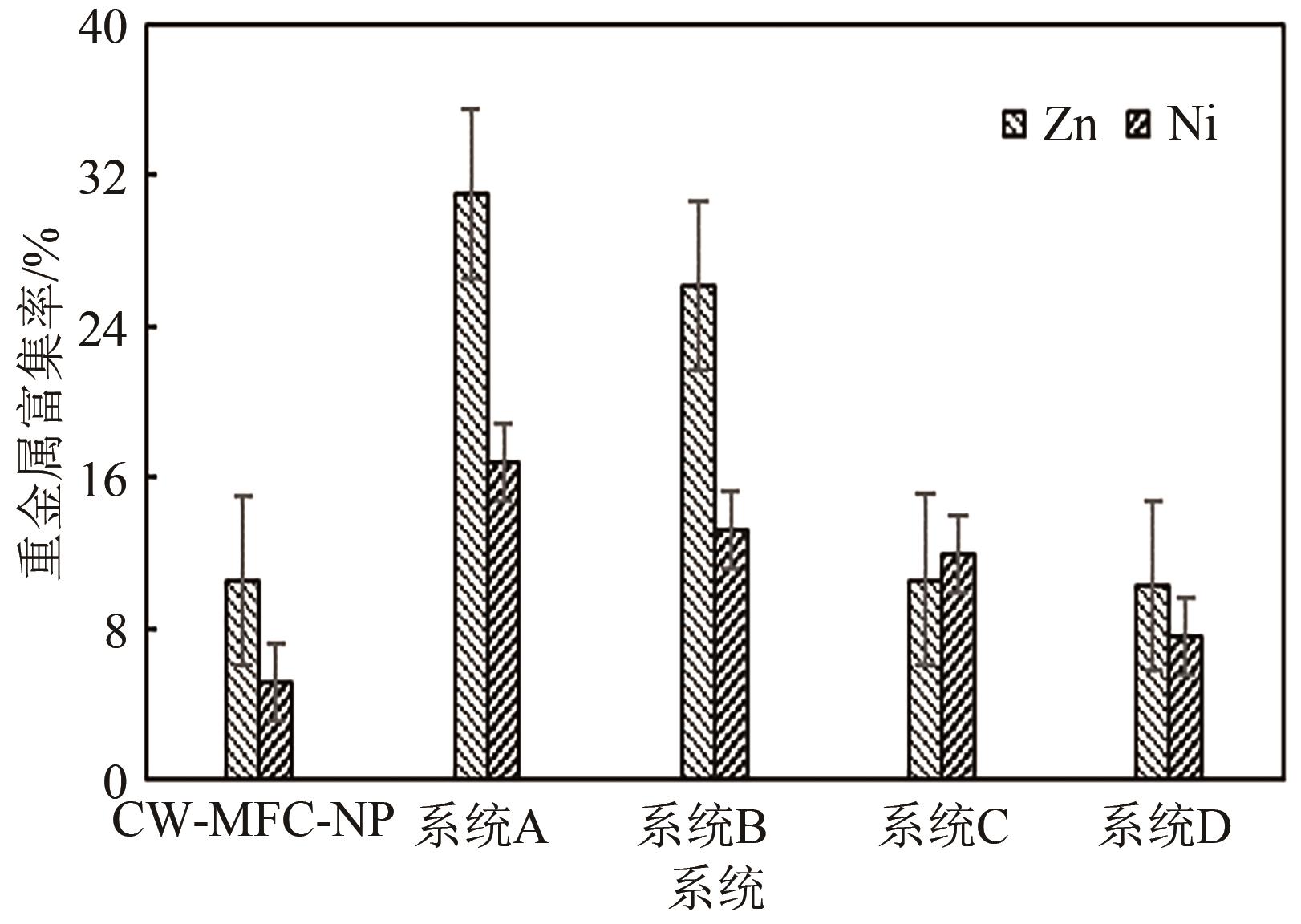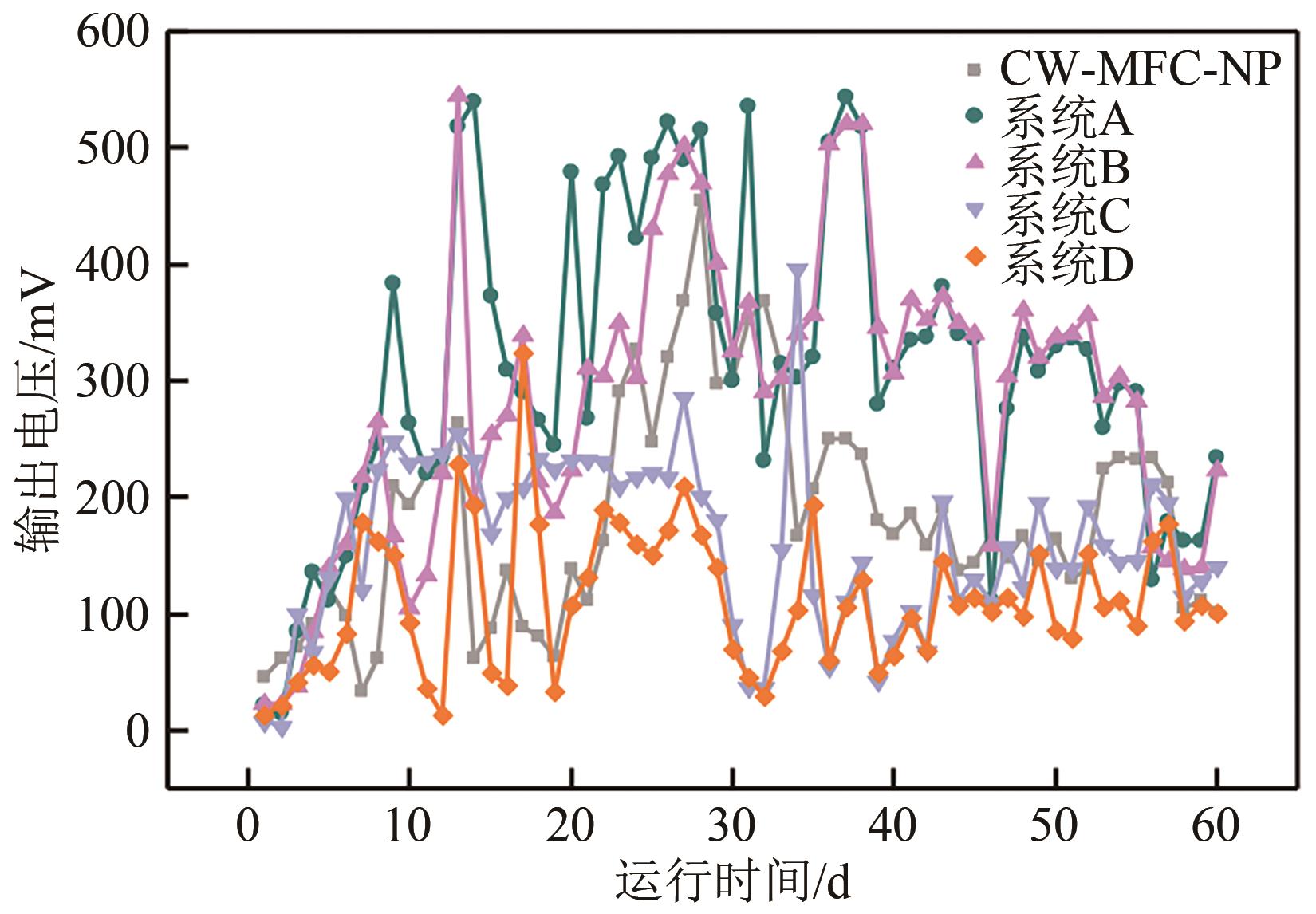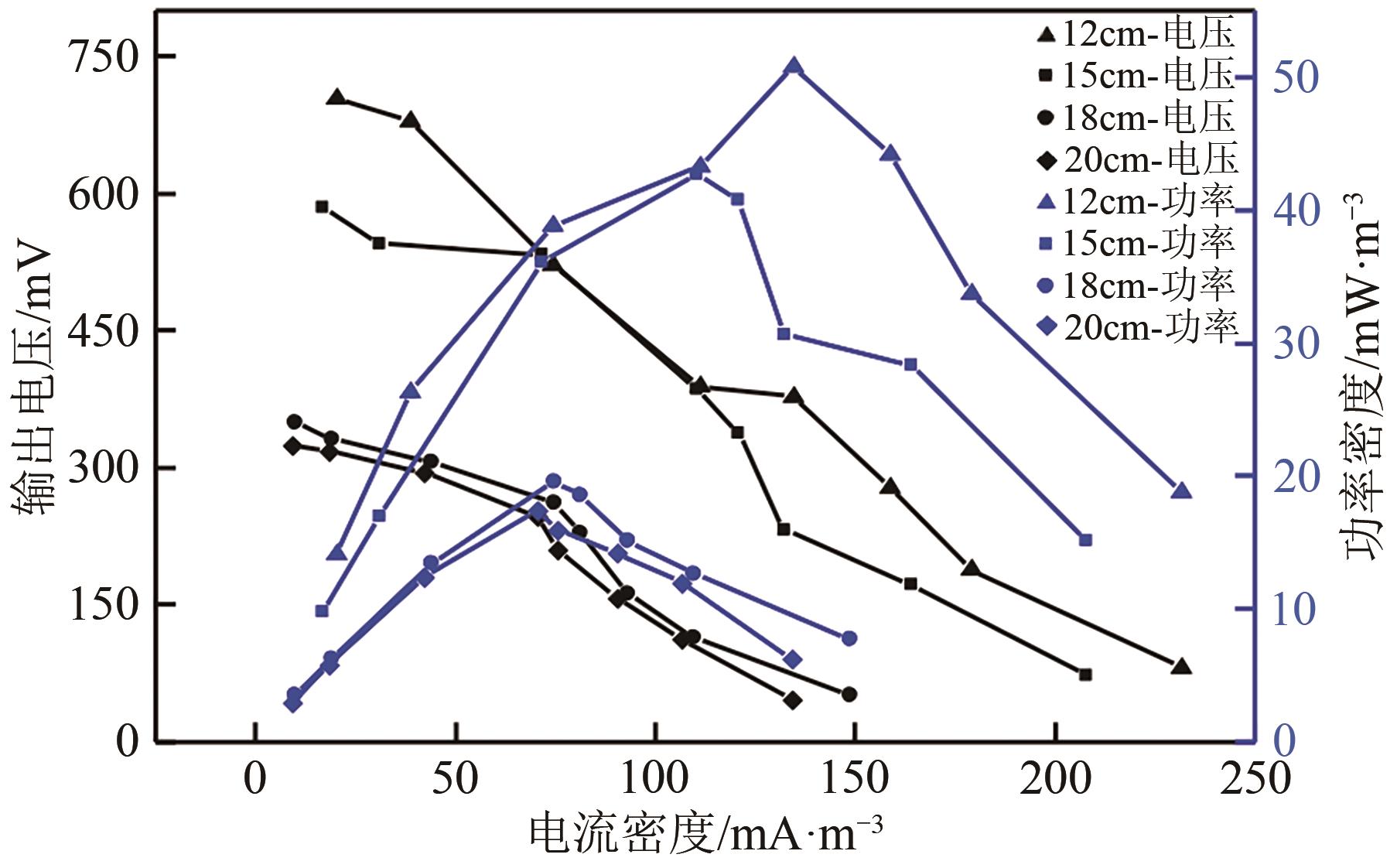化工进展 ›› 2021, Vol. 40 ›› Issue (7): 4074-4082.DOI: 10.16085/j.issn.1000-6613.2020-1665
电极间距对CW-MFC处理污泥中Zn和Ni的效果及其产电性能的影响
- 安徽工程大学化学与环境工程学院,安徽 芜湖 241000
-
收稿日期:2020-08-20修回日期:2020-09-30出版日期:2021-07-06发布日期:2021-07-19 -
通讯作者:徐大勇 -
作者简介:刘婷婷(1993—),女,硕士研究生,研究方向为城市剩余污泥资源化利用与土壤重金属污染修复。E-mail:1983293528@qq.com 。 -
基金资助:国家自然科学基金(51408001);安徽工程大学“中青年拔尖人才”培养计划;2019年度安徽工程大学研究生实践与创新项目
Effect of electrode spacing on the removal of Zn and Ni in sludge and its electricity generation performance by CW-MFC
LIU Tingting( ), XU Dayong(
), XU Dayong( ), WANG Lu, YANG Weiwei, XIA Yuyang
), WANG Lu, YANG Weiwei, XIA Yuyang
- College of Chemistry and Environmental Engineering, Anhui Polytechnic University, Wuhu 241000, Anhui, China
-
Received:2020-08-20Revised:2020-09-30Online:2021-07-06Published:2021-07-19 -
Contact:XU Dayong
摘要:
为有效提高传统人工湿地(CW)处理污泥重金属效能,本文构建了人工湿地微生物燃料电池(CW-MFC)用于污泥中Zn和Ni的去除,并考察了电极间距对Zn和Ni去除效果及其产电性能的影响。结果表明,不同电极间距(12cm、15cm、18cm和20cm)的CW-MFC对Zn的去除率分别为84.68%、64.56%、66.98%和50.23%,对Ni的去除率分别为74.14%、66.09%、64.00%和48.01%。其中,间距为12cm时系统对Zn和Ni去除效果最好,分别较CW提高了64%和26%,此时CW-MFC系统的最高输出电压和最大功率密度分别达到513mV和50.76mW/m3。X射线光电子能谱(XPS)分析显示污泥表层主要的重金属为Zn和Ni,且高价态的Zn和Ni被有效地转化为低价态或者单质金属。在间距为12cm的CW-MFC系统中,植物根系和电极对Zn、Ni的去除贡献最大,此时Zn在植物根系和电极中的富集率分别为23.76% 和30.97%,Ni的富集率分别为14.57%和16.78%。本研究表明CW-MFC对污泥重金属的去除及其产电性能具有较好的效果,并为CW-MFC的优化构建和城市污泥的处置及资源化利用提供了新的思路和借鉴。
中图分类号:
引用本文
刘婷婷, 徐大勇, 王璐, 杨伟伟, 夏宇扬. 电极间距对CW-MFC处理污泥中Zn和Ni的效果及其产电性能的影响[J]. 化工进展, 2021, 40(7): 4074-4082.
LIU Tingting, XU Dayong, WANG Lu, YANG Weiwei, XIA Yuyang. Effect of electrode spacing on the removal of Zn and Ni in sludge and its electricity generation performance by CW-MFC[J]. Chemical Industry and Engineering Progress, 2021, 40(7): 4074-4082.
| 含水率/% | pH | 重金属 | 质量分数/mg·kg-1 | 弱酸溶解态/% | 可还原态/% | 可氧化态/% | 残渣态/% |
|---|---|---|---|---|---|---|---|
| 90.81 | 7.15 | Zn | 3550.02 | 11.30 | 9.31 | 24.90 | 54.49 |
| Ni | 1552.50 | 15.53 | 17.68 | 30.39 | 36.40 |
表 1 初始污泥基本特征
| 含水率/% | pH | 重金属 | 质量分数/mg·kg-1 | 弱酸溶解态/% | 可还原态/% | 可氧化态/% | 残渣态/% |
|---|---|---|---|---|---|---|---|
| 90.81 | 7.15 | Zn | 3550.02 | 11.30 | 9.31 | 24.90 | 54.49 |
| Ni | 1552.50 | 15.53 | 17.68 | 30.39 | 36.40 |
| 参数 | CW | CW-MFC-NP | 系统A | 系统B | 系统C | 系统D |
|---|---|---|---|---|---|---|
| 阳极液pH | 6.88 | 6.78 | 6.82 | 6.92 | 7.04 | 6.75 |
| 阳极ORP/mV | -125 | -144 | -236 | -278 | -203 | -155 |
| 阴极ORP/mV | 102 | 87 | 108 | 121 | 134 | 132 |
| ORP梯度/mV | 227 | 231 | 344 | 399 | 337 | 287 |
表2 各系统电极的pH和ORP
| 参数 | CW | CW-MFC-NP | 系统A | 系统B | 系统C | 系统D |
|---|---|---|---|---|---|---|
| 阳极液pH | 6.88 | 6.78 | 6.82 | 6.92 | 7.04 | 6.75 |
| 阳极ORP/mV | -125 | -144 | -236 | -278 | -203 | -155 |
| 阴极ORP/mV | 102 | 87 | 108 | 121 | 134 | 132 |
| ORP梯度/mV | 227 | 231 | 344 | 399 | 337 | 287 |
| 处理系统 | 干重/g | 重金属 | 浓度/mg·kg-1 | 富集率/% | |||
|---|---|---|---|---|---|---|---|
| 根系 | 茎叶 | 根系 | 茎叶 | 根系 | 茎叶 | ||
| CW | 0.2136 | 0.5274 | Zn | 750.00 | 364.00 | 9.26 | 4.50 |
| Ni | 355.33 | 122.71 | 8.88 | 3.07 | |||
| 系统A | 0.2305 | 0.5507 | Zn | 1925.00 | 654.74 | 23.76 | 8.08 |
| Ni | 582.67 | 199.76 | 14.57 | 4.99 | |||
| 系统B | 0.2241 | 0.5488 | Zn | 1308.33 | 537.21 | 16.15 | 6.63 |
| Ni | 535.33 | 172.80 | 13.38 | 4.32 | |||
| 系统C | 0.2208 | 0.5305 | Zn | 1066.67 | 342.87 | 13.17 | 4.23 |
| Ni | 463.42 | 146.61 | 11.59 | 3.67 | |||
| 系统D | 0.2181 | 0.5279 | Zn | 834.00 | 215.60 | 10.30 | 2.66 |
| Ni | 378.90 | 120.70 | 9.47 | 3.02 | |||
表3 各系统中植物对重金属的富集情况
| 处理系统 | 干重/g | 重金属 | 浓度/mg·kg-1 | 富集率/% | |||
|---|---|---|---|---|---|---|---|
| 根系 | 茎叶 | 根系 | 茎叶 | 根系 | 茎叶 | ||
| CW | 0.2136 | 0.5274 | Zn | 750.00 | 364.00 | 9.26 | 4.50 |
| Ni | 355.33 | 122.71 | 8.88 | 3.07 | |||
| 系统A | 0.2305 | 0.5507 | Zn | 1925.00 | 654.74 | 23.76 | 8.08 |
| Ni | 582.67 | 199.76 | 14.57 | 4.99 | |||
| 系统B | 0.2241 | 0.5488 | Zn | 1308.33 | 537.21 | 16.15 | 6.63 |
| Ni | 535.33 | 172.80 | 13.38 | 4.32 | |||
| 系统C | 0.2208 | 0.5305 | Zn | 1066.67 | 342.87 | 13.17 | 4.23 |
| Ni | 463.42 | 146.61 | 11.59 | 3.67 | |||
| 系统D | 0.2181 | 0.5279 | Zn | 834.00 | 215.60 | 10.30 | 2.66 |
| Ni | 378.90 | 120.70 | 9.47 | 3.02 | |||
| 系统名称 | 最高输出电压/mV | 内阻/Ω | 最大功率密度/mW·m-3 |
|---|---|---|---|
| CW-MFC-NP | 264 | 583.43 | 19.72 |
| 系统A | 513 | 646.78 | 74.47 |
| 系统B | 545 | 526.24 | 84.05 |
| 系统C | 256 | 697.70 | 18.54 |
| 系统D | 228 | 877.15 | 14.71 |
表4 不同电极间距系统的产电性能统计
| 系统名称 | 最高输出电压/mV | 内阻/Ω | 最大功率密度/mW·m-3 |
|---|---|---|---|
| CW-MFC-NP | 264 | 583.43 | 19.72 |
| 系统A | 513 | 646.78 | 74.47 |
| 系统B | 545 | 526.24 | 84.05 |
| 系统C | 256 | 697.70 | 18.54 |
| 系统D | 228 | 877.15 | 14.71 |
| 1 | 郭广慧, 陈同斌, 杨军, 等. 中国城市污泥重金属区域分布特征及变化趋势[J]. 环境科学学报, 2014, 34(10): 2455-2461. |
| GUO Guanghui, CHEN Tongbin, YANG Jun, et al. Regional distribution characteristics and variation of heavy metals in sewage sludge of China[J]. Acta Scientiae Circumstantiae, 2014, 34(10): 2455-2461. | |
| 2 | ŠČANČAR J, MILAČIČ R, STRAŽAR M, et al. Total metal concentrations and partitioning of Cd, Cr, Cu, Fe, Ni and Zn in sewage sludge[J]. Science of the Total Environment, 2000, 250(1/2/3): 9-19. |
| 3 | MILLER F S, KILMINSTER K L, DEGENS B, et al. Relationship between metals leached and soil type from potential acid sulphate soils under acidic and neutral conditions in Western Australia[J]. Water, Air, and Soil Pollution, 2009, 205(1/2/3/4): 133-147. |
| 4 | 邱秀文, 周桂香, 王天烽, 等. 氧化硫硫杆菌JJU-1生物淋滤去除污泥中的重金属[J]. 环境工程学报, 2017, 11(9): 5201-5206. |
| QIU Xiuwen, ZHOU Guixiang, WANG Tianfeng, et al. Bioleaching of heavy metal from sewage sludge by Thiobacillus thiooxidan JJU-1[J]. Chinese Journal of Environmental Engineering, 2017, 11(9): 5201-5206. | |
| 5 | PENG G Q, TIAN G M, LIU J Z, et al. Removal of heavy metals from sewage sludge with a combination of bioleaching and electrokinetic remediation technology[J]. Desalination, 2011, 271(1/2/3): 100-104. |
| 6 | 朱亦珺.生物吸附法处理污泥中重金属镍[J]. 有色金属工程,2019, 9(7): 104-108. |
| ZHU Yijun. Disposal of sludge containing nickel heavy metals by biosorption[J]. Nonferrous Metals Engineering, 2019, 9(7): 104-108. | |
| 7 | 解道雷, 孔慈明, 徐龙乾, 等. 城市污泥中重金属存在形态、去除及稳定化研究进展[J]. 化工进展, 2018, 37(1): 330-342. |
| XIE Daolei, KONG Ciming, XU Longqian, et al. Developments of the speciation, removal and stabilization of heavy metals in municipal sludge[J]. Chemical Industry and Engineering Progress, 2018, 37(1): 330-342. | |
| 8 | SRIVASTAVA P, YADAV A K, MISHRA B K. The effects of microbial fuel cell integration into constructed wetland on the performance of constructed wetland[J]. Bioresource Technology, 2015, 195: 223-230. |
| 9 | NIELSEN S, BRUUN E W. Sludge quality after 10—20 years of treatment in reed bed systems[J]. Environmental Science and Pollution Research, 2015, 22(17): 12885-12891. |
| 10 | TAN X, YANG Y L, LIU Y W, et al. Enhanced simultaneous organics and nutrients removal in tidal flow constructed wetland using activated alumina as substrate treating domestic wastewater[J]. Bioresource Technology, 2019, 280: 441-446. |
| 11 | 林莉莉, 鲁汭, 龙忆年, 等. MFC处理人工湿地生物堵塞物及同步产电研究[J]. 环境科学研究, 2020, 33(6): 1504-1513. |
| LIN Lili, LU Rui, LONG Yinian, et al. MFC treating bio-clogging matter of constructed wetland and synchronous electricity generation[J]. Research of Environmental Sciences, 2020, 33(6): 1504-1513. | |
| 12 | 夏函青, 伍永钢, 江文亭, 等. 人工湿地-微生物燃料电池系统的发展及展望[J]. 化工进展, 2019, 38(12): 5548-5556. |
| XIA Hanqing, WU Yonggang, JIANG Wenting, et al. Review on development and prospect of constructed wetland coupled with microbial fuel cell[J]. Chemical Industry and Engineering Progress, 2019, 38(12): 5548-5556. | |
| 13 | ABOURACHED C, CATAL T, LIU H. Efficacy of single-chamber microbial fuel cells for removal of cadmium and zinc with simultaneous electricity production[J]. Water Research, 2014, 51: 228-233. |
| 14 | 印霞棐, 刘维平. 电极对微生物燃料电池同时处理有机废水和含铜重金属废水产电性能的影响[J]. 化工进展, 2015, 34(4): 1152-1158, 1170. |
| YIN Xiafei, LIU Weiping. The effects of electrode on the electricity generating capacity of microbial fuel cell in the treatment of organic wastewater and copper-contained heavy metal wastewater[J]. Chemical Industry and Engineering Progress, 2015, 34(4): 1152-1158, 1170. | |
| 15 | HABIBUL N, HU Y, WANG Y K, et al. Bioelectrochemical chromium (Ⅵ) removal in plant-microbial fuel cells[J]. Environmental Science & Technology, 2016, 50(7): 3882-3889. |
| 16 | WU M S, XU X, ZHAO Q, et al. Simultaneous removal of heavy metals and biodegradation of organic matter with sediment microbial fuel cells[J]. RSC Advances, 2017, 7(84): 53433-53438. |
| 17 | LU L, XING D, REN Z J. Microbial community structure accompanied with electricity production in a constructed wetland plant microbial fuel cell[J]. Bioresource Technology, 2015, 195: 115-121. |
| 18 | SRIVASTAVA P, YADAV A K, GARANIYA V, et al. Constructed wetland coupled microbial fuel cell technology: development and potential applications[M]. Amsterdam: Elsevier, 2019: 1021-1036. |
| 19 | ZHAO C C, SHANG D W, ZOU Y L, et al. Changes in electricity production and microbial community evolution in constructed wetland-microbial fuel cell exposed to wastewater containing Pb(Ⅱ)[J]. Science of the Total Environment, 2020, 732: 139127. |
| 20 | WANG Q, LYU R, RENE E R, et al. Characterization of microbial community and resistance gene (CzcA) shifts in up-flow constructed wetlands-microbial fuel cell treating Zn (Ⅱ) contaminated wastewater[J]. Bioresource Technology, 2020, 302: 122867. |
| 21 | WANG H C, CUI D, YANG L H, et al. Increasing the bio-electrochemical system performance in azo dye wastewater treatment: reduced electrode spacing for improved hydrodynamics[J]. Bioresource Technology, 2017, 245: 962-969. |
| 22 | 胡金凤, 徐龙君, 徐艳昭.电极间距对单室微生物燃料电池处理老龄垃圾渗滤液性能的影响[J]. 太阳能学报, 2019, 40(9): 2687-2694. |
| HU Jinfeng, XU Longjun, XU Yanzhao. Effect of electrode spacing on pollutions disposal in aged leachate and electricity production by single-chamber membrane-less air-cathodee MFC[J]. Acta Energiae Solaris Sinica, 2019, 40(9): 2687-2694. | |
| 23 | DOHERTY L, ZHAO Y Q, ZHAO X H, et al. Nutrient and organics removal from swine slurry with simultaneous electricity generation in an alum sludge-based constructed wetland incorporating microbial fuel cell technology[J]. Chemical Engineering Journal, 2015, 266: 74-81. |
| 24 | TIWARI B R, GHANGREKAR M M. Enhancing electrogenesis by pretreatment of mixed anaerobic sludge to be used as inoculum in microbial fuel cells[J]. Energy & Fuels, 2015, 29(5): 3518-3524. |
| 25 | LI X M, ZHANG W, LIU T X, et al. Changes in the composition and diversity of microbial communities during anaerobic nitrate reduction and Fe (Ⅱ) oxidation at circumneutral pH in paddy soil[J]. Soil Biology and Biochemistry, 2016, 94: 70-79. |
| 26 | YUAN Y, ZHOU S G, ZHUANG L. A new approach to in situ sediment remediation based on air-cathode microbial fuel cells[J]. Journal of Soils and Sediments, 2010, 10(7): 1427-1433. |
| 27 | 杨少龙, 韩志涛, 潘新祥, 等.电解条件对碱性还原电位水理化性质的影响[J]. 水处理技术, 2015, 41(9): 49-52. |
| YANG Shaolong, HAN Zhitao, PAN Xinxiang, et al. The influence of electrolytic condition on physicochemical properties of alkaline reduced water[J]. Technology of Water Treatment, 2015, 41(9): 49-52. | |
| 28 | 王辉. 微生物燃料电池(MFC)对典型土壤污染物的去除作用与机理[D]. 南京: 东南大学, 2018. |
| WANG Hui. The removal characteristics and mechanism of typical soil pollutants by microbial fuel cell[D]. Nanjing: Southeast University, 2018. | |
| 29 | HUANG G T, ZHANG Y C, TANG J W, et al. Remediation of Cd contaminated soil in microbial fuel cells: effects of Cd concentration and electrode spacing[J]. Journal of Environmental Engineering, 2020, 146(7): 04020050. |
| 30 | LIU Y Y, SHEN L, SONG P, et al. Nickel(Ⅱ) removal from wastewater by microbial fuel cell[J]. International Journal of Electrochemical Science, 2019, 14: 196-204. |
| 31 | AHMED M H, BYRNE J A, MCLAUGHLIN J, et al. Study of human serum albumin adsorption and conformational change on DLC and silicon doped DLC using XPS and FTIR spectroscopy[J]. Journal of Biomaterials and Nanobiotechnology, 2013, 4(2):194-203. |
| 32 | SVINTSITSKIY D A, SLAVINSKAYA E M, KARDASH T Y, et al. Low-temperature catalytic CO oxidation over mixed silver-copper oxide Ag2Cu2O3[J]. Applied Catalysis A: General, 2016, 510: 64-73. |
| 33 | WU Y N, ZHAO X, JIN M, et al. Copper removal and microbial community analysis in single-chamber microbial fuel cell[J]. Bioresource Technology, 2018, 253: 372-377. |
| 34 | LIU W, ZHANG J S, JIN Y J, et al. Adsorption of Pb(Ⅱ), Cd(Ⅱ) and Zn(Ⅱ) by extracellular polymeric substances extracted from aerobic granular sludge: efficiency of protein[J]. Journal of Environmental Chemical Engineering, 2015, 3(2): 1223-1232. |
| 35 | SHENG G D, YANG S T, SHENG J, et al. Macroscopic and microscopic investigation of Ni(Ⅱ) sequestration on diatomite by batch, XPS, and EXAFS techniques[J]. Environmental Science & Technology, 2011, 45(18): 7718-7726. |
| 36 | LIU Y Y, SONG P F, GAI R Z, et al. Recovering platinum from wastewater by charring biofilm of microbial fuel cells(MFCs)[J]. Journal of Saudi Chemical Society, 2019, 23(3): 338-345. |
| 37 | 唐静文.土壤微生物燃料电池产电性能及其修复Cd污染土壤效果的研究[D]. 上海: 华东理工大学,2018. |
| TANG Jingwen. Study on the electricity production performance of soil microbial fuel cells and its the remediation to Cd contaminated soil[D]. Shanghai: East China University of Science and Technology, 2018. | |
| 38 | CHENG S, LOGAN B E. High hydrogen production rate of microbial electrolysis cell(MEC) with reduced electrode spacing[J]. Bioresource Technology, 2011, 102(3): 3571-3574. |
| 39 | KONDAVEETI S, MOON J M, MIN B. Optimum spacing between electrodes in an air-cathode single chamber microbial fuel cell with a low-cost polypropylene separator[J]. Bioprocess and Biosystems Engineering, 2017, 40(12): 1851-1858. |
| 40 | NOORI P, NAJAFPOUR DARZI G. Enhanced power generation in annular single‐chamber microbial fuel cell via optimization of electrode spacing using chocolate industry wastewater[J]. Biotechnology and Applied Biochemistry, 2016, 63(3): 427-434. |
| 41 | 王艳芳, 刘百仓, 郑哲, 等. 电极面积和电极间距对立方体型MFCs产电能力的影响[J]. 可再生能源, 2013, 31(8): 68-74. |
| WANG Yanfang, LIU Baicang, ZHENG Zhe, et al. Effects of the electrode area and electrode spacing on the electricity generation capacity of MFCs[J]. Renewable Energy Resources, 2013,31(8): 68-74. | |
| 42 | RAMAN K, LAN J C W. Performance and kinetic study of photo microbial fuel cells(PMFCs) with different electrode distances[J]. Applied Energy, 2012, 100: 100-105. |
| 43 | LOGAN B E, HAMELERS B, ROZENDAL R, et al. Microbial fuel cells: methodology and technology[J]. Environmental Science & Technology, 2006, 40(17): 5181-5192. |
| 44 | DENG H, CHEN Z, ZHAO F. Energy from plants and microorganisms: progress in plant-microbial fuel cells[J]. ChemSusChem, 2012, 5(6): 1006-1011. |
| [1] | 张明焱, 刘燕, 张雪婷, 刘亚科, 李从举, 张秀玲. 非贵金属双功能催化剂在锌空气电池研究进展[J]. 化工进展, 2023, 42(S1): 276-286. |
| [2] | 胡喜, 王明珊, 李恩智, 黄思鸣, 陈俊臣, 郭秉淑, 于博, 马志远, 李星. 二硫化钨复合材料制备与储钠性能研究进展[J]. 化工进展, 2023, 42(S1): 344-355. |
| [3] | 张杰, 白忠波, 冯宝鑫, 彭肖林, 任伟伟, 张菁丽, 刘二勇. PEG及其复合添加剂对电解铜箔后处理的影响[J]. 化工进展, 2023, 42(S1): 374-381. |
| [4] | 李世霖, 胡景泽, 王毅霖, 王庆吉, 邵磊. 电渗析分离提取高值组分的研究进展[J]. 化工进展, 2023, 42(S1): 420-429. |
| [5] | 张杰, 王放放, 夏忠林, 赵光金, 马双忱. “双碳”目标下SF6排放现状、减排手段分析及未来展望[J]. 化工进展, 2023, 42(S1): 447-460. |
| [6] | 许春树, 姚庆达, 梁永贤, 周华龙. 共价有机框架材料功能化策略及其对Hg(Ⅱ)和Cr(Ⅵ)的吸附性能研究进展[J]. 化工进展, 2023, 42(S1): 461-478. |
| [7] | 李梦圆, 郭凡, 李群生. 聚乙烯醇生产中回收工段第三、第四精馏塔的模拟与优化[J]. 化工进展, 2023, 42(S1): 113-123. |
| [8] | 马伊, 曹世伟, 王家骏, 林立群, 邢延, 曹腾良, 卢峰, 赵振伦, 张志军. 低共熔溶剂回收废旧锂离子电池正极材料的研究进展[J]. 化工进展, 2023, 42(S1): 219-232. |
| [9] | 雷伟, 姜维佳, 王玉高, 和明豪, 申峻. N、S共掺杂煤基碳量子点的电化学氧化法制备及用于Fe3+检测[J]. 化工进展, 2023, 42(9): 4799-4807. |
| [10] | 钱思甜, 彭文俊, 张先明. PET熔融缩聚与溶液解聚形成环状低聚物的对比分析[J]. 化工进展, 2023, 42(9): 4808-4816. |
| [11] | 李卫华, 于倩雯, 尹俊权, 吴寅凯, 孙英杰, 王琰, 王华伟, 杨玉飞, 龙於洋, 黄启飞, 葛燕辰, 何依洋, 赵灵燕. 酸雨环境下填埋飞灰吨袋破损后重金属的溶出行为[J]. 化工进展, 2023, 42(9): 4917-4928. |
| [12] | 李志远, 黄亚继, 赵佳琪, 于梦竹, 朱志成, 程好强, 时浩, 王圣. 污泥与聚氯乙烯共热解重金属特性[J]. 化工进展, 2023, 42(9): 4947-4956. |
| [13] | 史天茜, 石永辉, 武新颖, 张益豪, 秦哲, 赵春霞, 路达. Fe2+对厌氧氨氧化EGSB反应器运行性能的影响[J]. 化工进展, 2023, 42(9): 5003-5010. |
| [14] | 常印龙, 周启民, 王青月, 王文俊, 李伯耿, 刘平伟. 废弃聚烯烃的高值化学回收研究进展[J]. 化工进展, 2023, 42(8): 3965-3978. |
| [15] | 王报英, 王皝莹, 闫军营, 汪耀明, 徐铜文. 聚合物包覆膜在金属分离回收中的研究进展[J]. 化工进展, 2023, 42(8): 3990-4004. |
| 阅读次数 | ||||||
|
全文 |
|
|||||
|
摘要 |
|
|||||







